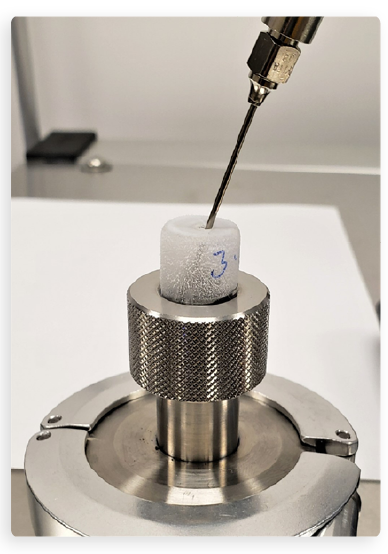Cold and Ultra Cold Vial Helium Leak Testing
THE CHALLENGE
A global pharmaceutical entity (Client B) approached Leak
Detection Associates (LDA, now a PTI company) with vials for
helium leak testing services. The vials were of the same size; however,
one was of glass composition and the other was a thermoplastic material.
Each contained the same neck finish to accommodate a press-fit integral crimp/stopper component. They
were interested to see how various temperature storage conditions might affect their helium leak rates. The
temperatures of interest were refrigerated (2 - 8°C), -40°C, -60°C, and -80°C.
THE SOLUTION
Client B provided LDA one hundred (100) 2R size
glass and plastic vials that were prepared by first
drilling a hole (3.2mm dia.) in the base of each
sample. After cleaning residual debris, the crimp/
stoppers were applied to the finish using a small
arbor press. The purpose of the hole was to supply
100% helium gas during the leak test cycle. This
procedure is known as the 100% Helium Flow or
Continuous Helium Flow method. This was a client
stipulated method since they did not want to
introduce potential leaks by puncturing the stoppers
to allow helium into the sealed vials. Each vial set
(25 samples) were allowed to condition at their test
temperature for 24 hours prior to helium leak testing.
After the conditioning period, vial samples were individually
analyzed utilizing a SIMS helium leak detector machine.
Once removed from the cold environment, the sample was
immediately placed on the vacuum test fixture and the leak
test cycle was initiated. Approximately 20 seconds into the
leak test, a tube was inserted into the exposed hole in the
vial base and a flow of helium gas (25cc/min) continued for
10 seconds. The initial test cycle allowed for the leak rate to
stabilize prior to introducing the helium gas. Any increase in
the helium leak rate would indicate a leak pathway from the
crimp/stopper area since this was the only section of the vial
exposed to the helium leak detector. Once the full test cycle
was completed, the next vial sample was removed from cold
storage and the same test procedure was repeated until all
25 vials were completed. Subsequent leak tests of the other
cold storage conditions were carried out by first allowing the
24 hour conditioning period of the vial sets. Helium leak rate
data was collected from all four vial sets.

THE RESULT
After collecting and tabulating the helium leak rate data from each of the four temperature storage conditions,
it was of interest to note that all of the vial samples did not exhibit any helium leakage – all were in the low/mid
10-9 mbar-L/sec. This leak rate level is well below the Kirsch helium leak rate criteria (10-6 mbar-L/sec) ensuring
that these vials would most likely not encounter microbial or sterility problems during their intended shelf life.
This study confirmed to the client that their press-fit vial crimp system was extremely robust, even well beyond
the glass transition temperatures of most rubber stopper compounds.